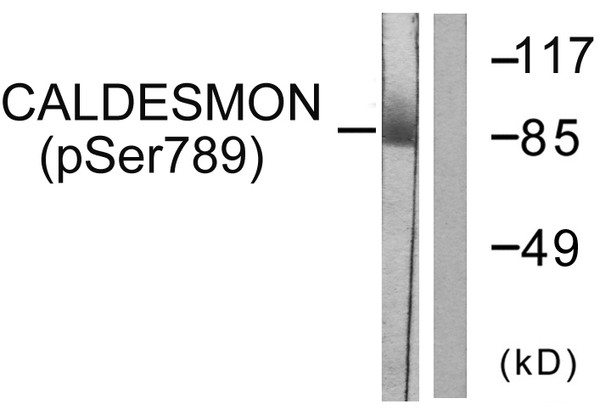| Post Translational Modifications | In non-muscle cells, phosphorylation by CDK1 during mitosis causes caldesmon to dissociate from microfilaments. Phosphorylation reduces caldesmon binding to actin, myosin, and calmodulin as well as its inhibition of actomyosin ATPase activity. Phosphorylation also occurs in both quiescent and dividing smooth muscle cells with similar effects on the interaction with actin and calmodulin and on microfilaments reorganization. CDK1-mediated phosphorylation promotes Schwann cell migration during peripheral nerve regeneration. |
| Function | Actin- and myosin-binding protein implicated in the regulation of actomyosin interactions in smooth muscle and nonmuscle cells (could act as a bridge between myosin and actin filaments). Stimulates actin binding of tropomyosin which increases the stabilization of actin filament structure. In muscle tissues, inhibits the actomyosin ATPase by binding to F-actin. This inhibition is attenuated by calcium-calmodulin and is potentiated by tropomyosin. Interacts with actin, myosin, two molecules of tropomyosin and with calmodulin. Also plays an essential role during cellular mitosis and receptor capping. Involved in Schwann cell migration during peripheral nerve regeneration. |
| Protein Name | CaldesmonCdm |
| Database Links | Reactome: R-HSA-445355 |
| Cellular Localisation | CytoplasmCytoskeletonMyofibrilStress FiberOn Thin Filaments In Smooth Muscle And On Stress Fibers In Fibroblasts (Nonmuscle) |
| Alternative Antibody Names | Anti-Caldesmon antibodyAnti-Cdm antibodyAnti-CALD1 antibodyAnti-CAD antibodyAnti-CDM antibody |
Information sourced from Uniprot.org













![Western blot analysis of lysates from wild type (WT) and UHRF1 knockdown (KD) 293T cells using [KD Validated] UHRF1 Rabbit pAb (STJ11107094) at 1:1000 dilution incubated overnight at 4°C. <br>Secondary antibody: HRP-conjugated Goat anti-Rabbit IgG (H+L) (STJS000856) at 1:10000 dilution. <br>Lysates/proteins: 25 Mu g per lane. <br>Blocking buffer: 3% nonfat dry milk in TBST. <br>Detection: ECL Basic Kit ( Western blot analysis of lysates from wild type (WT) and UHRF1 knockdown (KD) 293T cells using [KD Validated] UHRF1 Rabbit pAb (STJ11107094) at 1:1000 dilution incubated overnight at 4°C. <br>Secondary antibody: HRP-conjugated Goat anti-Rabbit IgG (H+L) (STJS000856) at 1:10000 dilution. <br>Lysates/proteins: 25 Mu g per lane. <br>Blocking buffer: 3% nonfat dry milk in TBST. <br>Detection: ECL Basic Kit (](https://cdn11.bigcommerce.com/s-zso2xnchw9/images/stencil/600x533/products/186290/408031/STJ11107094_1__47275.1744894467.jpg?c=1)